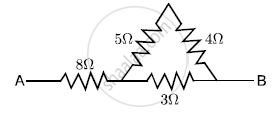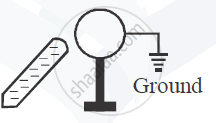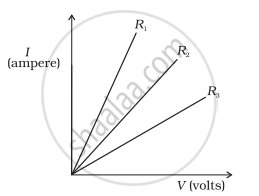Advertisements
Advertisements
प्रश्न
Answer the following question.
Distinguish between Ohmic and non-ohmic substances; explain with the help of example.
उत्तर
| Ohmic substances | Non-ohmic substances |
| 1. Substances which obey ohm’s law are called ohmic substances | 1. Substances which do not obey ohm’s law are called non-ohmic substances. |
| 2. Potential difference (V) versus current (I) curve is a straight line. | 2. Potential difference (V) versus current (I) curve is not a straight line. |
| 3. Resistance of these substances is constant i.e. they follow linear I-V characteristic. | 3. Resistance of these substances is a function of V or I. |
| 4. Expression for resistance is, R = `"V"/"I"` | 4. Expression for resistance is, R = `lim_(Δ"l"→0)(Δ"V")/(Δ"I")="dV"/"dI"` |
| 5. Examples: Gold, silver, copper etc. | 5. Examples: Liquid electrolytes, vacuum tubes, junction diodes, thermistors etc. |
APPEARS IN
संबंधित प्रश्न
Find the resistance of a conductor if 0.24 A current is passing through it and a potential difference of 24 V is applied across it.
The relationship between the potential difference and the current in a conductor is stated in the form of a law.
1) Name the law.
2) What does the slope of V-I graph for a conductor represent?
3) Name the material used for making the connecting wire.
What is Resistivity?
Find the expression for the resistivity of a material and state the SI unit of resistivity.
When a 12 V battery is connected across an unknown resistor, there is a current of 2.5 mA in the circuit. Calculate the value of the resistance of the resistor.
The resistors R1, R2, R3 and R4 in the figure given below are all equal in value.

What would you expect the voltmeter A, B and C to read assuming that the connecting wires in the circuit have negligible resistance?
- Draw a V-I graph for a conductor obeying Ohm’s law.
- What does the slope of V–I graph for a conductor represent?
What is an ohmic resistor? Give one example of an ohmic resistor. Draw a graph to show its current voltage relationship. How is the resistance of the resistor determined from this graph?
In a conductor 6.25 × `10^16` electrons flow from its end A to B in 2 s. Find the current flowing through the conductor (e = 1.6 × `10^-19` C)
A car bulb connected to a 12 volt battery draws 2 A current when glowing. What is the resistance of the filament of the bulb? Will the resistance be more same or less when the bulb is not glowing?
Calculate the current flowing through a wire of resistance 5 Ω connected to a battery of potential difference 3 V.
What length of copper wire of resistivity 1.7 × 10-8 Ω m and radius 1 mm is required so that its resistance is 2Ω?
Calculate the electric field in a copper wire of cross-sectional area 2.0 mm2 carrying a current of 1 A.
The resistivity of copper = 1.7 × 10–8 Ω m
Calculate the effective resistance across AB?

A metal sphere is kept on an insulting stands. A negatively charged rod is brought near it, then the sphere is earthed as shown. On removing the earthing, and taking the negatively charged rod away, what will be the nature of charge on the sphere? Give reason for your answer.

Define the following:
(i) Coulomb
(ii) Ohm
State the relation correlating the electric current flowing in a conductor and the voltage applied across it. Also, draw a graph to show this. relationship.
Ohm’s law states the relationship between power and voltage.
State Ohm’s law.
Two cells each of 5V are connected in series across an 8Ω resistor and three parallel resistors of 4Ω, 6Ω, and 12Ω. Draw a circuit diagram for the above arrangement. Calculate
- the current drawn from the cell
- current through each resistor
The temperature of a conductor is increased. The graph best showing the variation of its resistance is:
A student carries out an experiment and plots the V-I graph of three samples of nichrome wire with resistances R1, R2 and R3 respectively. Which of the following is hue?

A student carries out an experiment and plots the V-I graph of three samples of nichrome wire with resistances R1, R2 and R3 respectively. Which of the following is true?

State Ohm’s law? How can it be verified experimentally? Does it hold good under all conditions? Comment.
Ohm's law deals with the relationship between ______
Consider a current carrying wire (current I) in the shape of a circle. Note that as the current progresses along the wire, the direction of j (current density) changes in an exact manner, while the current I remain unaffected. The agent that is essentially responsible for is ______.
How is electric current related to the potential difference across the terminals of a conductor?
Draw a labelled circuit diagram to verify this relationship.
